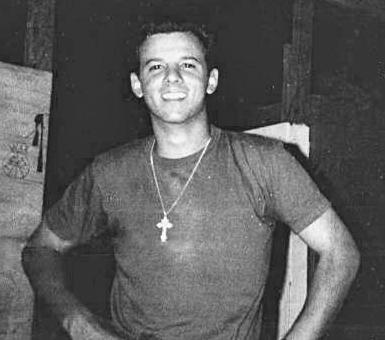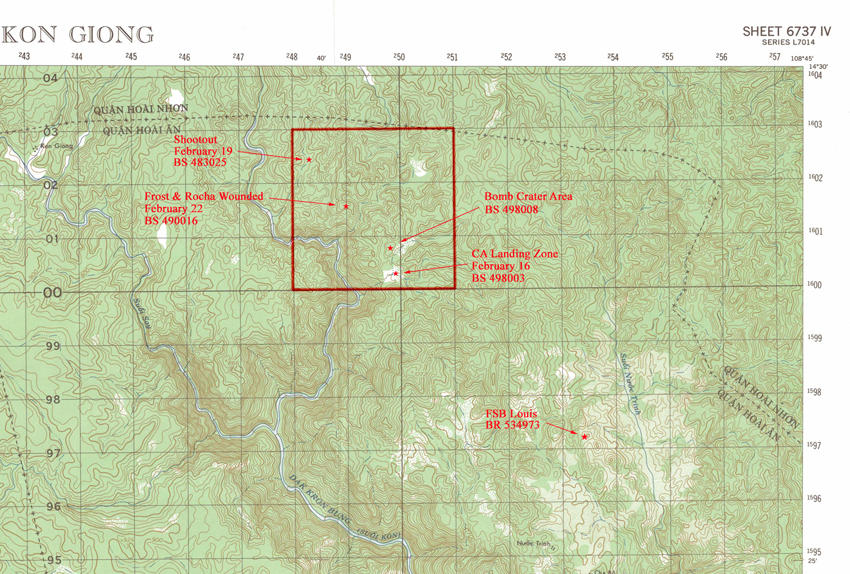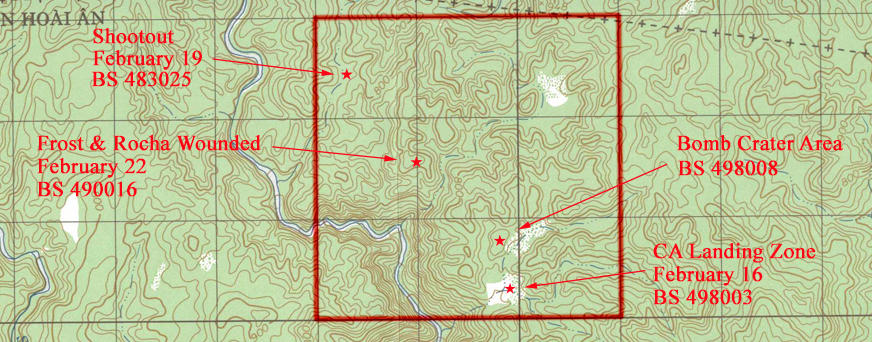![]() 1st Battalion 22nd Infantry
1st Battalion 22nd Infantry ![]()
February
1970
I have observed in life, not just
my Army adventures or Vietnam adventures but most aspects of
life, that with the passage of time facts are
sometimes enhanced. Sometimes such enhancements become an
embellishment, which becomes an exaggeration, which becomes a
lie.
So, in my opinion, it’s best to try not to enhance the
facts, and the truth. Simply let it stand. I tried to do that to
the best of my ability.
I desperately want my stories to be historical in nature as well
as personal narratives.
I served in Company B’s 2nd
platoon, 1-22 Infantry, 4th Infantry Division, I was in SGT
Buenzle’s squad. At that time the squad consisted
of SGT Buenzle, me Jim Henderson, Greg Bodell and possibly either
Alan Sloan or John Broussard or maybe both. Either four or maybe
five
of us. I carried an M79 grenade launcher, the others carried
M16’s. Longtime member Paul Flartey left sometime in early
Feb, headed home, his
tour of duty completed.
Standing, left
to right: Photo courtesy of Paul Flartey |
Greg "Tiger Man" Bodell Photo courtesy of Paul Flartey |

John Broussard
The month of February started off
with us having been CA’d, Combat Assaulted, from one unknown
location in the field on January 31st
to another unknown location in the field. We had no down time.
Simply get on the chopper in one place fly a while, get off in
another place.
I have no idea of the place, only the date. So, from 1 Feb until
12 Feb, we are in some unknown particular AO, Area of Operation,
until the 12th.
It must have been an uneventful twelve days, which is always a
relief. On the 12th we are CA’d to yet another unknown
location in the field where
we spend the rest of the 12th , and all day and night the 13th
before being CA’d once again on the 14th. We stay that day
and night and then on
the 15th we are once again CA’d to another unknown location
and spend the night there. You can see how a grunt winds up with
an Air Medal,
you ride in the open doorway of a lot of choppers. On the 16th we
are CA’d to an AO that comes to be known as the POW AO. This
shall
become clear later. The official Unit History refers to this as
Operation Wayne Stab II. Of course, we had no idea of such a
naming at the time
and I have no idea now as to what it stood for but that is how
the Unit History describes it.
I recall that the CA of the 16th
was into an area of tall elephant grass, perhaps 5-6 feet tall.
It was a large open area that allowed for several choppers
at a time to land. The Logs do not state the exact location, but
I believe it to be 498-003. The pilot of the chopper that I was
on did not want to
touch down because he could not see the ground because of the
tall grass. He was wanting to hover and for us to jump from 4-5
feet in the air.
That is an awfully long way when you have an extra 80-100 lbs.
strapped on your back. Some areas were marshy, and guys sank
nearly to their
waist in water and muck. A few thought they might drown! I do not
recall my landing being marshy, but I did worry about breaking my
fool neck!
But we all made it. Being that the LZ, landing zone, was on low
ground we immediately began humping up the nearest hill, in order
to gain high
ground. We usually tried to avoid low ground whenever possible.
Also, everyone within miles would have seen and heard the
choppers landing.

Above: Section of Map Sheet 6737 IV
Red outlined square indicates AO (Area
of Operations) of Company B 1-22 Infantry in February 1970.
FSB (Fire Support Base) Louis is in lower right, Dak Kron Bung
River is in center,
winding its way from north to south.

Above: Section of Map Sheet 6737 IV showing locations of events in the story.
Once we got to the top of said
hill, Grids 498-008, we were surprised to see that it had been
the site of an air strike and that it was somewhat
cleared out and had numerous bomb craters. We liked this, as
maybe we could use the craters in place of having to dig our own
fox holes.
Some of the craters were quite large, maybe from 500 and 1000lb
bombs, although I’m not an expert on that topic. They were,
I would guess,
five to six feet deep at the very bottom and could quite easily
hold six to ten men.
We immediately began to set up a
platoon size, appx 25-man, perimeter for our night location or
November Lima, as we often called it. It was
still early enough that we were able to run some patrols. All
patrols were to be S&D, search and destroy. Third platoon had
found a highly traveled
trail right from their LZ in the elephant grass. They followed it
and made contact with 3 NVA, killing 2. They also found a very
large hootch,
a hootch being what could be described as a house or a building
with a dirt floor and thatch straw walls and roof, capable of
sleeping 20 people
in the case of a very large one.
One of 2nd platoon’s patrols
had also made contact and employed small arms fire on 1 NVA found
in an area with 3 large hootches. One of the
hootches seemed to be a mess hall of some type, being set up for
cooking and having a large table. All of the hootches we found
and those 3rd
platoon found had a “basement “of sorts, the same size
as the hootch, and covered with logs. The logs covered with dirt
and serving as the floor
of the hootch. They had tunnels running from hootch to hootch.
They were set up more as protection from artillery or air strikes
than as fighting
positions. Anything we found was very recently abandoned. The S-3
Daily Logs record these events as occurring at 1700 and 1730, so
somewhat
late in the day. As darkness fell, we return to the CP, Command
Post, and we spend the night of the 16th atop the hill among the
bomb craters.
While in this AO, each platoon
operated independently of one another, but each platoon would
send out what we called night ambushes, or
bushwhacks, a squad, usually a rifle squad and not generally an
M60 machine gun team, would head out of the CP perimeter and
would usually
head down a trail maybe 50-200 yards, which is a long way to be
out alone so to speak, only 4-6 men. We would set up trip flares
in each direction
on the trail, about 10 yards apart. Then we would break brush a
short distance off to one side of the trail, maybe 10 yards. We
would set up
2 Claymore mines facing the trail. And sit and wait. It was nerve
racking and instead of one man on guard while the others slept,
usually everyone
stayed awake all night because it was so stressful. If either of
the flares were tripped, the general idea was that we would pop
the claymores and
open up with everything we had and then hightail it back up the
trail to the CP, hoping our own people didn’t shoot us as we
came back in.
Claymore mine with its firing device and wire |
M49A1 Surface Trip flare |
I recall being on one such night
ambush and the platoon CP contacted us on the PRC25, radio, and
told us to maintain strict radio silence
and break squelch only, no talking. Each platoon had at least two
PRC 25’s, maybe more, and the night ambush would carry one
in order to
communicate back with the platoon CP. We would usually have one
when out on patrol during the day also. On this particular night,
it was
Buenzle’s squad only, so 4 maybe 5 of us. The CP tells us to
stay on 100% alert because Higher Higher, that’s how we
referred to anything or
anyone above company size headquarters, had reported a kilo size
element in the area. Scared the crap out of us! A kilo size
element! What was a
“kilo” anyway we knew NOTHING about the metric system
in 1969-70. A KILO! Didn’t that mean 1,000, we pondered
silently among ourselves.
So, we’re 5 guys alone and there might be 1,000 enemy
soldiers in the neighborhood! I don’t think anyone even
breathed the rest of the night.
We were quiet as little church mice. I don’t think we ever
figured out what they meant nor why they used the term
“kilo”. The ambush passed
without incident.
On the morning of the 17th , we
sent out various patrols, keeping the bomb crater area as our CP,
Command Post. The patrols would be squad
size, appx 4-6 men. Usually two patrols in opposite directions.
Occasionally, two squads would join together and thus be composed
of 10-12 men.
Two squads stayed back with the CP. Most of the time the squad
that had the ambush the night before would get to stay in the
perimeter and the
other squads would go on the daytime patrol.
According to the 1-22 Unit
History, Co B’s second platoon, SGT Buenzle’s squad
myself included, finds 2 hootches , 1 bunker with a fighting
position. The records show later we report finding 2 more
hootches, barns, big piles of clothes, and animals in pens. We
find one hootch with a
bed with wooden stocks for restraining a person’s ankles.
Reminiscent of something from the old Salem witch hunts. It was
at this point that we
realized we were in a POW camp. We continued to find more items,
7 more hootches, for a total of 12. We continue to find a lot of
documents,
malaria tablets, toothbrushes and toothpaste, canteens, a bag of
rice, 6 dozen kerosene lanterns, 3 ruck sacks, fish nets, a pack
of 2x2 bandages,
candles, an M16 magazine, 6 ponchos and a 40 lb can of corn are
among only some of what we found. The S-3 Logs list too much for
me to
include all of it here. There had obviously been a lot of people
here. We had landed right in their back yard.
There were some pigs running
around loose and we radioed for permission to shoot one, wanting
to cook it later that night. Permission was granted
and I think it was Bob Frost that drew the honors of dispatching
one of them. I recall being surprised at how hard it was to kill,
Bob had to shoot it
two or three times before it died. But it eventually succumbed
and as darkness begins to fall, we haul it back to the CP.
|
|
|
Above and left: Above: Three photos of Bob "Rawhide" Frost Photos courtesy of Paul Flartey and Harry Beck |
Once back at the CP, someone
begins to skin and clean the pig. Someone else radios to base
camp for permission to cook it and eat it. The
Battalion Surgeon, located at An Khe base camp, who is usually an
officer and also usually an actual doctor, doesn’t want to
grant permission
for us to eat it. He’s, of course, reluctant to give the OK
as he’s afraid we’ll undercook it and contract
trichinosis or some other food borne illness.
Finally, he relents, and we’re allowed to cook the pig. We
cook it in the bottom of one of the bomb craters so the fire
would not be visible to our
enemies. Barbecued pork for supper!
Other companies of the Battalion
are also finding many hootches and bunkers and equipment and
engaging in contact with the enemy,
particularly C Company. The Logs are full of these encounters and
contain too much equipment and material for me to list.
At our night location, the night passes uneventfully.
Home | Photos | Battles & History | Current |
Rosters & Reports | Medal of Honor | Killed
in Action |
Personnel Locator | Commanders | Station
List | Campaigns |
Honors | Insignia & Memorabilia | 4-42
Artillery | Taps |
What's New | Editorial | Links |